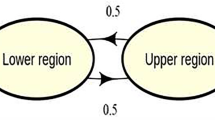Abstract
A general framework for threshold parameters in population dynamics is developed using the concept of target reproduction numbers. This framework identifies reproduction numbers and other threshold parameters in the literature in terms of their roles in population control. The framework is applied to the analysis of single and multiple control strategies in ecology and epidemiology, and this provides new biological insights.


Similar content being viewed by others
References
Allen LJS, van den Driessche P (2008) The basic reproduction number in some discrete-time epidemic models. J Differ Equ Appl 14:1127–1147
Anderson RM, May RM (1991) Infectious diseases of humans: dynamics and control. Oxford University Press, Oxford
Bani-Yaghoub M, Gautam R, Shuai Z, van den Driessche P, Ivanek R (2012) Reproduction numbers for infections with free-living pathogens growing in the environment. J Biol Dyn 6:923–940
Berman A, Plemmons RJ (1979) Nonnegative matrices in the mathematical sciences. Academic Press, New York
Caswell H (2001) Matrix population models: construction, analysis, and interpretation, 2nd edn. Sinauer Associates, Sunderland
Chow L, Fan M, Feng Z (2011) Dynamics of a multigroup epidemiological model with group-targeted vaccination strategies. J Theor Biol 291:56–64
Cosner C, Beier JC, Cantrell RS, Impoinvil D, Kapitanski L, Potts MD, Troyo A, Ruan S (2009) The effect of human movement on the persistence of vector-borne diseases. J Theor Biol 258:550–560
Cushing JM, Diekmann O (2016) The many guises of \(R_0\) (a didactic note). J Theor Biol 404:295–302
Cushing JM, Zhou Y (1994) The net reproductive value and stability in matrix population models. Nat Resour Model 8:297–333
de-Camino-Beck T, Lewis MA (2007) A new method for calculating net reproductive rate from graph reduction with applications to the control of invasive species. Bull Math Biol 69:1341–1354
de-Camino-Beck T, Lewis MA (2008) On net reproductive rate and the timing of reproductive output. Am Nat 172:128–139
Diekmann O, Heesterbeek JAP, Roberts MG (2010) The construction of next-generation matrices for compartmental epidemic models. J R Soc Interface 7:873–885
Diekmann O, Heesterbeek JAP, Britton T (2013) Mathematical tools for understanding infectious disease dynamics. Princeton University Press, Princeton
Guo H, Li MY, Shuai Z (2006) Global stability of the endemic equilibrium of multigroup SIR epidemic models. Can Appl Math Q 14:259–284
Heesterbeek JAP, Roberts MG (2007) The type-reproduction number \(T\) in models for infectious disease control. Math Biosci 206:3–10
Heffernan JM, Smith RJ, Wahl LM (2005) Perspectives on the basic reproduction ratio. J R Soc Interface 2:281–293
Hinz HL, McClay A (2000) Ten years of scentless chamomile: Prospects for the biological control of a weed of cultivated land. In: Proceedings of the X international symposium on biological control of weeds, pp 537–550
Huang Q, Lewis MA (2015) Home fidelity and reproductive rate for migratory populations. Theor Ecol 8:187–205
Keeling MJ, Grenfell BT (2000) Individual-based perspectives on \(R_0\). J Theor Biol 203:51–61
Knipl D (2016) A new approach for designing disease intervention strategies in metapopulation models. J Biol Dyn 10:71–94
Lajmanovich A, Yorke JA (1976) A deterministic model for gonorrhea in a nonhomogeneous population. Math Biosci 28:221–236
Li C-K, Schneider H (2002) Applications of Perron–Frobenius theory to population dynamics. J Math Biol 44:450–462
Li J, Blakeley D, Smith RJ (2011) The failure of \(R_0\). Comput Math Models Med, Article ID 527610
Lloyd AL, May RM (1996) Spatial heterogeneity in epidemic models. J Theor Biol 79:1–11
Moon JW, Shuai Z, van den Driessche P (2014) Walks and cycles on a digraph with application to population dynamics. Linear Algebra Appl 451:182–196
Roberts MG (2007) The pluses and minuses of \(R_0\). J R Soc Interface 4:949–961
Roberts MG, Heesterbeek JAP (2003) A new method for estimating the effort required to control an infectious disease. Proc R Soc Lond B 270:1359–1364
Rueffler C, Metz JAJ (2013) Necessary and sufficient conditions for \(R_0\) to be a sum of contributions of fertility loops. J Math Biol 66:1099–1122
Rueffler C, Metz JAJ, Van Dooren TJM (2013) What life cycle graphs can tell about the evolution of life histories. J Math Biol 66:225–279
Saad-Roy CM, Shuai Z, van den Driessche P (2015) Models of Bovine Babesiosis including juvenile cattle. Bull Math Biol 77:514–547
Shuai Z, Heesterbeek JAP, van den Driessche P (2013) Extending the type reproduction number to infectious disease control targeting contacts between types. J Math Biol 67:1067–1082. [Also see the erratum, J. Math. Biol., 71:255–257 (2015)]
van den Driessche P (2017) Reproduction numbers of infectious disease models. Infect Dis Modell 2:288–303
van den Driessche P, Watmough J (2002) Reproduction numbers and sub-threshold endemic equilibria for compartmental models of disease transmission. Math Biosci 180:29–48
West DB (1996) Introduction to graph theory. Prentice Hall, Upper Saddle River
Acknowledgements
The authors would like to thank the Mathematical Biosciences Institute (MBI) at The Ohio State University, which receives its funding through the NSF Grant DMS 1440386, for providing support via two MBI workshops in which this research was initiated and improved. We thank two anonymous reviewers for helpful comments.
Author information
Authors and Affiliations
Corresponding author
Additional information
Publisher's Note
Springer Nature remains neutral with regard to jurisdictional claims in published maps and institutional affiliations.
This research was partially supported by the Natural Science and Engineering Research Council of Canada (NSERC) through Discovery Grants (MAL and PvdD), by the Canada Research Chair program (MAL), and by the National Science Foundation (NSF) through the Grant DMS 1716445 (ZS).
Rights and permissions
About this article
Cite this article
Lewis, M.A., Shuai, Z. & van den Driessche, P. A general theory for target reproduction numbers with applications to ecology and epidemiology. J. Math. Biol. 78, 2317–2339 (2019). https://doi.org/10.1007/s00285-019-01345-4
Received:
Revised:
Published:
Issue Date:
DOI: https://doi.org/10.1007/s00285-019-01345-4




